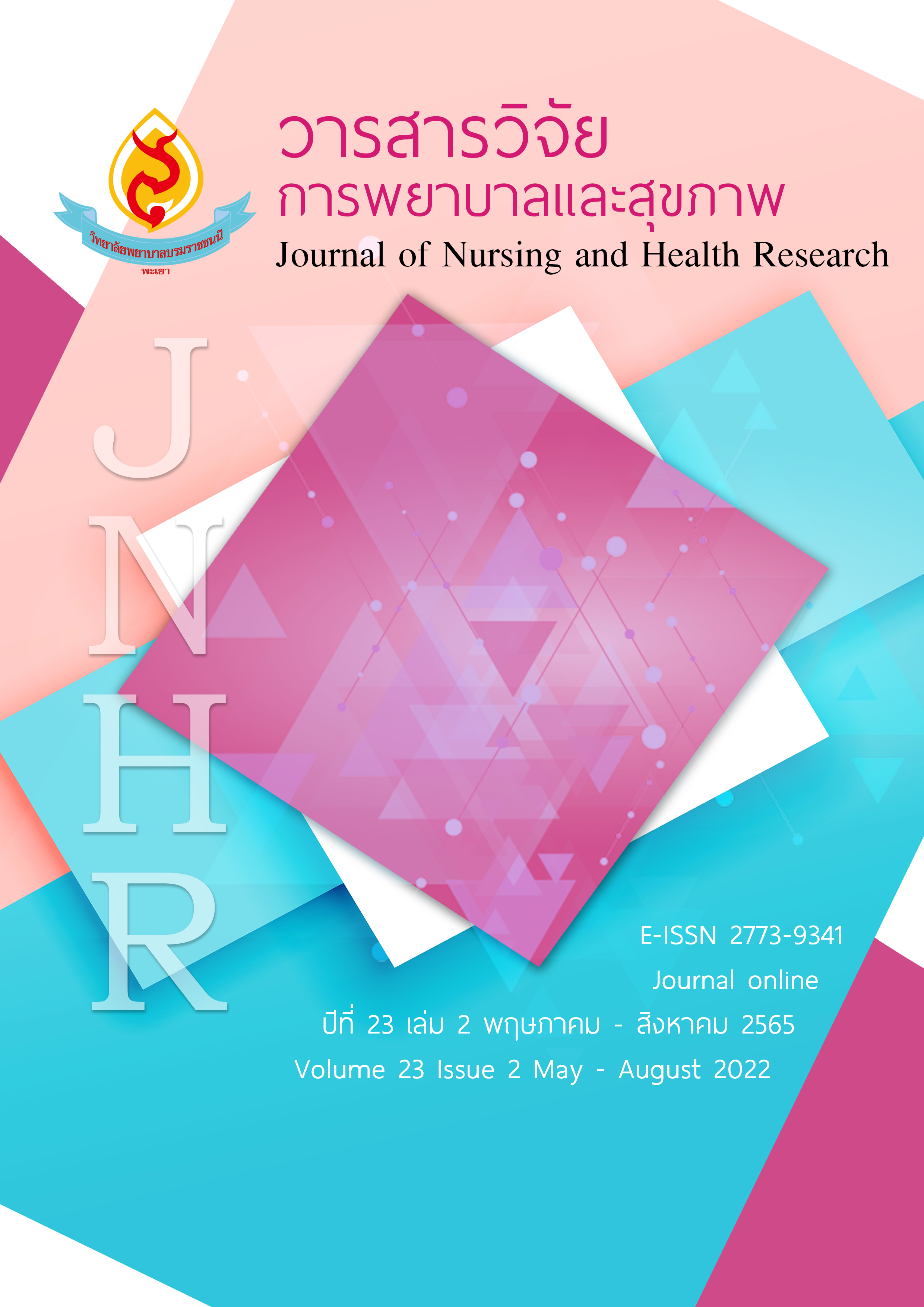รูปแบบการพัฒนาสมรรถนะพยาบาลวิชาชีพในการจัดการภาวะเร่งด่วนของผู้ป่วย โรคหลอดเลือดสมองระยะวิกฤต โดยการเรียนรู้ผ่านสถานการณ์จำลอง
คำสำคัญ:
รูปแบบการพัฒนาสมรรถนะ, การจัดการภาวะเร่งด่วน, ผู้ป่วยโรคหลอดเลือดสมองระยะวิกฤต, การเรียนรู้ ผ่านสถานการณ์จำลองบทคัดย่อ
การวิจัยเชิงปฏิบัติการครั้งนี้มีวัตถุประสงค์เพื่อพัฒนาและศึกษาผลของการใช้รูปแบบการพัฒนาสมรรถนะพยาบาลวิชาชีพในการจัดการภาวะเร่งด่วนของผู้ป่วยโรคหลอดเลือดสมองระยะวิกฤต โดยการเรียนรู้ผ่านสถานการณ์จำลอง ผู้มีส่วนร่วมในการศึกษาครั้งนี้ คือ พยาบาลวิชาชีพที่มีประสบการณ์ 2 ปีขึ้นไป จำนวน 20 คน เครื่องมือที่ใช้ในการศึกษาครั้งนี้ ประกอบด้วย 1) เครื่องมือที่ใช้ในการดำเนินการวิจัย ได้แก่ สถานการณ์จำลองผู้ป่วยโรคหลอดเลือดสมองระยะวิกฤต ตรวจสอบความตรงเชิงเนื้อหาโดยผู้ทรงคุณวุฒิ 5 ท่าน ได้ค่าความตรงเชิงเนื้อหาเท่ากับ .96 2) เครื่องมือที่ใช้ในการเก็บรวบรวมข้อมูล ได้แก่ แบบประเมินความรู้ แบบประเมินความสามารถ และแบบประเมินความพึงพอใจ
ต่อรูปแบบการพัฒนาสมรรถนะพยาบาลวิชาชีพในการจัดการภาวะเร่งด่วนของผู้ป่วยโรคหลอดเลือดสมองระยะวิกฤต โดยการเรียนรู้ผ่านสถานการณ์จำลอง ตรวจสอบความตรงเชิงเนื้อหาโดยผู้ทรงคุณวุฒิ 5 ท่าน ได้ค่าความตรงเชิงเนื้อหาเท่ากับ .96, 1 และ .96 ตามลำดับ แบบประเมินความพึงพอใจได้ค่าความเที่ยงสัมประสิทธิ์อัลฟ่าของครอนบาค เท่ากับ .97 วิเคราะห์ข้อมูลโดยใช้สถิติเชิงพรรณนาและวิเคราะห์เนื้อหา ผลการศึกษา พบว่า รูปแบบการพัฒนาสมรรถนะพยาบาลวิชาชีพในการจัดการภาวะเร่งด่วนของผู้ป่วยโรคหลอดเลือดสมองระยะวิกฤต โดยการเรียนรู้
ผ่านสถานการณ์จำลอง ประกอบด้วย 1) ระยะเตรียมความรู้ในการจัดการภาวะเร่งด่วนของผู้ป่วยโรคหลอดเลือดสมอง
ระยะวิกฤต 2) ระยะปฏิบัติการจัดการภาวะเร่งด่วนของผู้ป่วยโรคหลอดเลือดสมองระยะวิกฤตตามสถานการณ์จำลอง และ 3) ระยะประเมินผล ความรู้ ความสามารถ และความพึงพอใจต่อรูปแบบการพัฒนาสมรรถนะพยาบาลวิชาชีพ ผลของการใช้รูปแบบการพัฒนาสมรรถนะพยาบาลวิชาชีพในการจัดการภาวะเร่งด่วนของผู้ป่วยโรคหลอดเลือดสมองระยะวิกฤตโดยการเรียนรู้ผ่านสถานการณ์จำลอง พบว่า ด้านความรู้ ด้านการบริหารยา และการตัดสินใจ ผ่านเกณฑ์ คิดเป็นร้อยละ 100 ด้านความสามารถในการจัดการภาวะเร่งด่วน ด้านการบริหารยา และการตัดสินใจ ผ่านเกณฑ์
คิดเป็นร้อยละ 100 และความพึงพอใจต่อรูปแบบการพัฒนาสมรรถนะภาพรวมอยู่ในระดับมากที่สุด (=4.58, SD=.50) ผู้บริหารทางการพยาบาลสามารถนำผลการวิจัยไปใช้เป็นแนวทางในการส่งเสริมสมรรถนะพยาบาลวิชาชีพในการจัดการภาวะเร่งด่วนของผู้ป่วยโรคหลอดเลือดสมองระยะวิกฤตในโรงพยาบาล
เอกสารอ้างอิง
กัลยา ปวงจันทร์ และ ศิริกาญจน์ จินาวิน. (2563). ผลการใช้แนวปฏิบัติการพยาบาลการดูแลผู้ป่วยโรคหลอดเลือดสมองตีบหรืออุดตันระยะเฉียบพลัน โรงพยาบาลแพร่. วารสารโรงพยาบาลแพร่, 28(2), 1-17
ชูศักดิ์ เอกเพชร. (2561). การวิจัยปฏิบัติการ. สุราษฏร์ธานี. สืบค้นเมื่อ 2 มิถุนายน 2565, จาก https://graduate.sru.ac.th/wp-content/uploads/2018/11/Action-Research-1.pdf
นลินี พสุคันธภัค และ สุวรรณา วิภาคสงเคราะห์. (2557). การพัฒนาเกณฑ์สมรรถนะเฉพาะทางของพยาบาลวิชาชีพโรคหลอดเลือดสมอง. วารสารกองการพยาบาล, 41(1), 74-87.
นลินี พสุคันธภัค, สายสมร บริสุทธิ์, และวันเพ็ญ ภิญโญภาสกุล. (2559). แนวทางการพยาบาลผู้ป่วยโรคหลอดเลือดสมองสำหรับพยาบาลทั่วไป. กรุงเทพฯ: ธนาเพรส จำกัด.
นันทวัฒน์ ภัทรกรนันท์. (2559). ศาสตร์และศิลป์การสอนผู้ใหญ่. วารสารศึกษาศาสตร์มหาวิทยาลัยศิลปากร, 14(2), 40-53.
พรพิไล นิยมถิ่น. (2562). การพัฒนารูปแบบการอบรมการช่วยฟื้นคืนชีพขั้นสูงสำหรับทีมกู้ชีพโรงพยาบาลสมเด็จพระยุพราชด่านซ้าย จังหวัดเลย. วารสารโรงพยาบาลสกลนคร, 22(3), 22-30.
มาลี คำคง และ ปรียานุช ชัยกองเกียรติ. (2560). การจัดการเรียนรู้โดยใช้สถานการณ์จำลองขั้นสูง: วิธีพัฒนาสมรรถนะทางการพยาบาล. วารสารเครือข่ายวิทยาลัยพยาบาลและการสาธารณสุขภาคใต้, 4(พิเศษ), 332-344
เมธิณี เกตวาธิมาตร. (2560). บทบาทของพยาบาลวิชาชีพในการจัดการดูแลผู้ป่วยโรคหลอดเลือดสมองขาดเลือดในระยะวิกฤต. วารสารวิจัยทางวิทยาศาสตร์สุขภาพ,11(2), 71-80.
วิทยาลัยแพทย์ฉุกเฉินแห่งประเทศไทย. (2563). แนวทางการรักษาและให้ยาละลายลิ่มเลือดสำหรับโรคหลอดเลือดสมองตีบเฉียบพลันภายนอกโรงพยาบาลและที่ห้องฉุกเฉินปี พ.ศ. 2563. กรุงเทพมหานคร: วิทยาลัยแพทย์ฉุกเฉินแห่งประเทศไทย.
สมจิตต์ สินธุชัย และ กันยารัตน์ อุบลวรรณ. (2560). การเรียนรู้โดยใช้สถานการณ์จำลองเสมือนจริง: การนำไปใช้ในการจัดการเรียนการสอน. วารสารพยาบาลทหารบก, 18(1), 29-38.
สุมลชาติ ดวงบุบผา และ สุนทรี เจียรวิทยกิจ. (2562). การประเมินผลการใช้เทคนิคการสอนด้วยสถานการณ์จำลองทางคลินิกในการฝึกปฏิบัติการพยาบาลของนักศึกษาพยาบาล. รามาธิบดีพยาบาลสาร, 25(2), 208-266.
อรนันท์ หาญยุทธ. (2557). กระบวนการพยาบาลและการนำไปใช้. วารสารพยาบาลทหารบก, 15(3), 137-143.
Kemmis, S. & Mc Taggart, R. (1990). The action research planner. (3rd ed.). Victoria: Deakin University press
Kolb, D. A. (2014). Experiential learning: experience as the source of learning and development (2nd ed.). NJ: Pearson Edu.
Lewis, R., Strachan, A. & Smith, M. M. (2012). Is high fidelity simulation the most effective method for the development of non-technical skills in nursing? a review of the current evidence. The Open Nursing Journal, 6, 82-89.
Wang, A. L. & Fitzpatrick, J. J. (2013). Use of simulation among Chinese nursing students. Clinical Simulation in Nursing, 9(8), e311–e317.
ดาวน์โหลด
เผยแพร่แล้ว
รูปแบบการอ้างอิง
ฉบับ
ประเภทบทความ
สัญญาอนุญาต
ลิขสิทธิ์ (c) 2022 วารสารวิจัยการพยาบาลและสุขภาพ

อนุญาตภายใต้เงื่อนไข Creative Commons Attribution-NonCommercial-NoDerivatives 4.0 International License.



